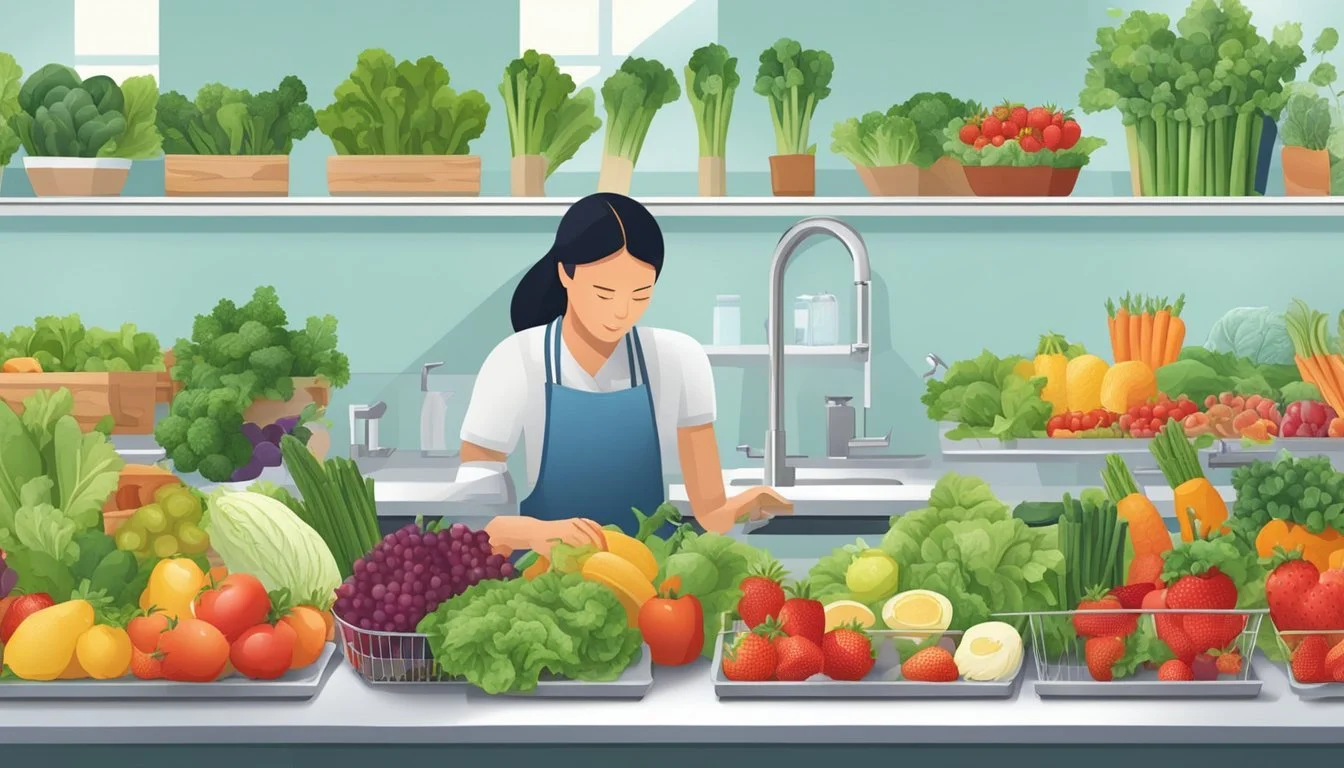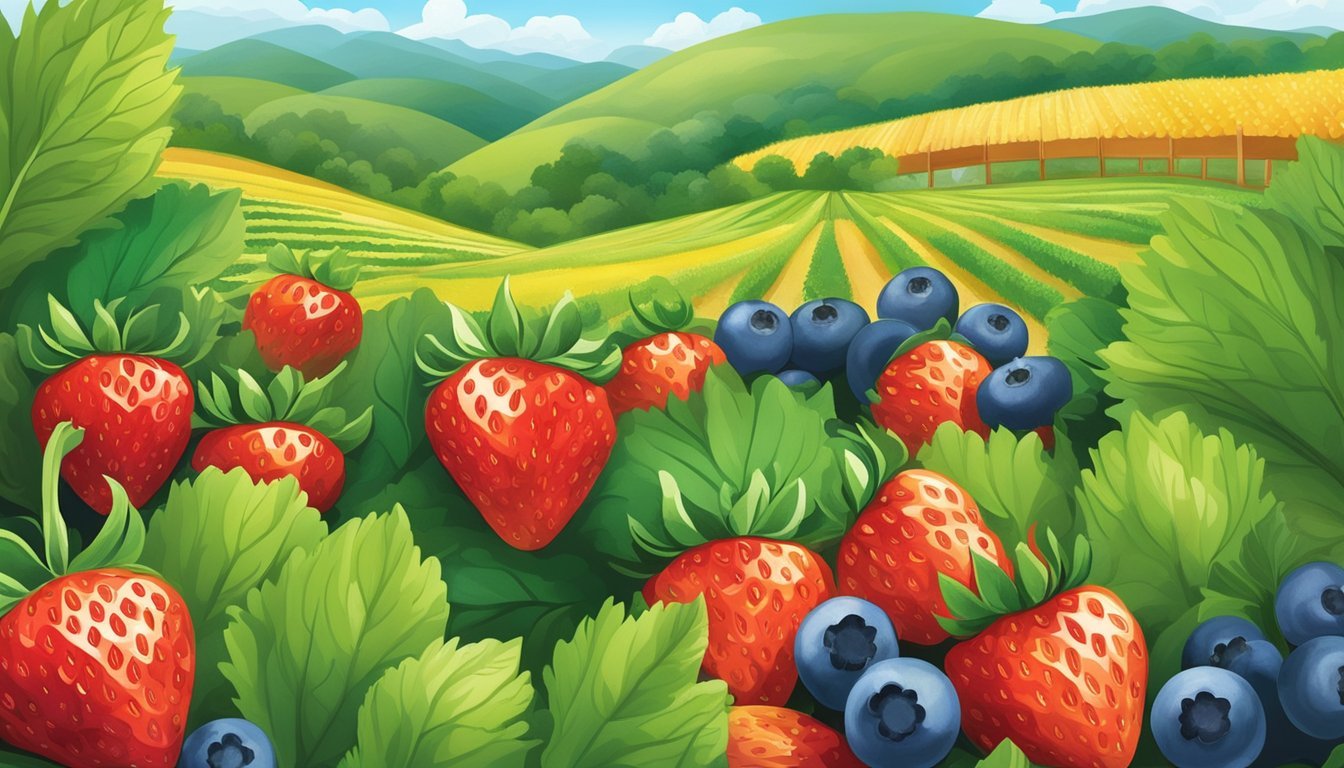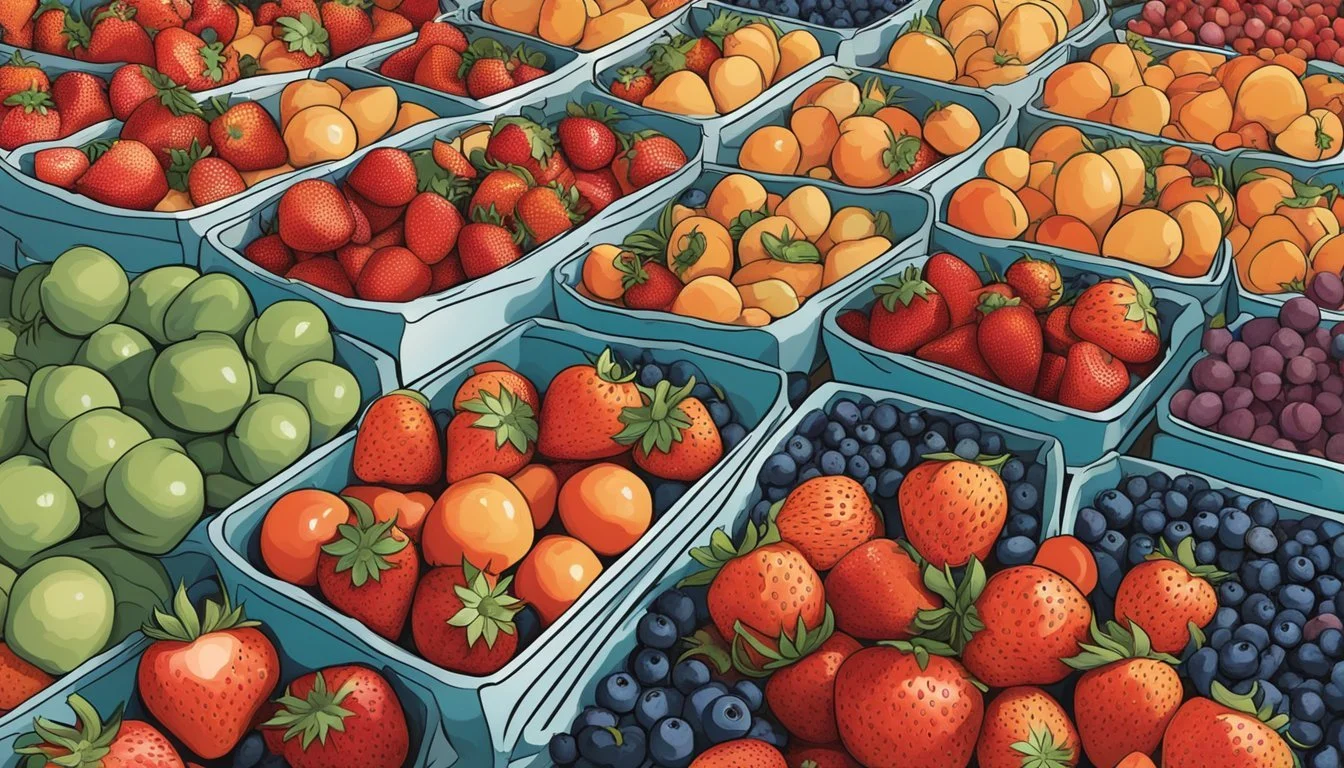North Carolina Seasonal Fruit & Vegetables in April
Your Fresh Guide
This Article is Part of our North Carolina Seasonal Fruit & Veg Calendar
April in North Carolina marks a season of abundance for fresh produce as the state transitions from the cool vestiges of winter into the warmer embrace of spring. This is a prime month for consumers and chefs alike to access a variety of fruits and vegetables at their peak freshness. The state's agriculture benefits from the region's rich soil and varying climate, resulting in a diverse array of produce available in April.
During this month, North Carolina's farms begin to yield crops such as tender asparagus (What wine goes well with asparagus?), flavorful radishes, and crisp lettuces like romaine. These vegetables are not only at their peak in terms of flavor but also boast optimal nutritional value. Availability extends to other spring favorites, including a variety of peas and turnips, offering a fresh taste of the season to any table.
The emphasis on seasonality ensures that the produce consumers find at markets and stores supports local farmers and minimizes the carbon footprint associated with long-distance transportation of goods. The availability of these fresh, seasonal offerings in April lays the foundation for nutritious and environmentally conscious eating habits as North Carolinians enjoy the fruits of their local agriculture.
The Climate Influence on Produce
The seasonal produce available in North Carolina is heavily influenced by the region's distinct springtime climate.
Understanding Spring Weather in North Carolina
In spring, North Carolina experiences a temperate climate which contributes to the growth and harvest timings of its produce. April, specifically, marks a transition with warmer temperatures and increased rainfall, conditions that are conducive to the growth of a variety of fruits and vegetables. While summer brings peak heat and encourages the ripeness of many fruits, spring is crucial for the initial growth phase of these crops following the colder winter months.
Heading into fall, temperatures cool, and different produce items come into season, but the groundwork for many of North Carolina's fruit and vegetable yields begins with the conditions set in the earlier parts of the year. Thus, understanding and predicting the subtle seasonal climate variations is key for both growers and consumers to anticipate the availability of local produce.
Seasonal Vegetables in April
April in North Carolina brings a variety of vegetables peaking in freshness and flavor. Consumers can enjoy a range of leafy greens, root vegetables, and cruciferous options, making it a perfect time to indulge in the state's seasonal bounty.
Leafy Greens Availability
During April, leafy greens thrive in North Carolina's spring climate. Shoppers can find vibrant, fresh varieties perfect for salads and cooking.
Kale: Sturdy and nutrient-rich, kale remains a favorite.
Spinach: Tender spinach leaves are ideal for a hearty spring salad.
Lettuce: Various types, including romaine, are crispy and fresh.
Root Vegetables and Their Peak Times
Root vegetables harvested in April are known for their flavorful and nutritious profiles.
Radishes: These crisp, peppery vegetables are excellent fresh or as a zesty addition to dishes.
Carrots: Sweet and crunchy, carrots harvested now are particularly flavor-packed.
Beets: Earthy and deep in color, beets are versatile for both sweet and savory preparations.
Cruciferous Vegetables in Season
April marks a continued season for several cruciferous vegetables, known for their health benefits.
Broccoli (how long does broccoli last?): Fresh broccoli is readily available and ideal for a variety of dishes, from roasting to steaming.
Cauliflower: Consumers can enjoy the mild flavor of cauliflower, which serves as a great canvas for spices and herbs.
Cabbage: Cabbage is in its prime, offering a sweet crunch that's perfect for slaws or ferments.
Seasonal Fruits in April
In North Carolina, April ushers in the beginning of berry season and the emergence of fruit blossoms. Consumers can anticipate the market's offerings to start shifting towards the fresher, sweeter tastes of spring.
Berry Season Kickoff
Strawberries make their debut in April, heralding the start of North Carolina's berry season. They are typically ripe and ready for picking throughout the month. Although blueberries are often associated with May into July, there might be early varieties available towards the end of April in warmer microclimates.
Fruit Trees Blossoming in North Carolina
Fruit trees across North Carolina begin to blossom in April, setting the stage for later harvests. While the fruits themselves are not yet ready to be picked, the blossoming trees are a sign that fresh, locally-grown fruit like peaches and plums will be available in the coming months.
Herbs and More
In April, gardeners and consumers in North Carolina can revel in the abundance of herbs that thrive during this month, as well as other fresh produce that peaks in spring.
Popular Herbs to Grow and Harvest
Arugula (how long does arugula last?) - This peppery green makes an excellent salad base and is perfect for an April harvest.
Chard - With its vibrant leaves, chard is as nutritious as it is attractive in a garden, ready for picking in spring.
Parsley - A versatile herb used in a multitude of dishes, parsley grows well during the cooler days of early spring.
Cilantro and dill are two herbs that not only enhance flavor profiles but also prefer the milder temperatures of April to flourish. Both can be sown directly into the soil as soon as the ground is workable in early spring.
Other Produce Items
Apart from herbs, other produce items come into season.
Fennel (how long does fennel last?) stands out with its unique, anise-like flavor and can be used in salads or as a fragrant addition to roasts.
Greens such as arugula and chard not only elevate salads and side dishes with their freshness but also add a splash of color to the spring palette.
These items thrive in the cool to mild climate of April in North Carolina and are excellent choices for those looking to enjoy seasonal freshness.
Preparing and Using Seasonal Produce
In April, North Carolina's gardens begin to yield a variety of fresh produce, each with its unique flavor and texture. Utilizing these ingredients at their peak can significantly enhance the quality of every meal.
Cooking Tips for Fresh Produce
Springtime in North Carolina brings fresh vegetables such as asparagus, spring radishes, and turnips, as well as broccoli and soft crabs (What wine goes well with crab?). Here are some tips for cooking these seasonal delights:
Asparagus: Steam or grill for a tender side dish. A touch of olive oil, salt, and lemon zest (how long does lemon zest last?) can enhance its natural flavors.
Spring Radishes: Slice thinly and add to salads for a crisp, peppery bite, or cook them for a milder flavor.
Turnips: Roast with other root vegetables or mash them for a comforting dish.
Broccoli: Ideal for stir-fries, steaming, or incorporating in casseroles.
Soft Crabs: Typically fried or sautéed, they offer a seafood option that complements springtime menus.
Incorporating these vegetables into recipes ensures meals are infused with the freshness and flavor of the season. One can make vibrant salads, hearty stews, or light, refreshing sides that showcase one's favorite fruits and vegetables.
Storage and Preservation
Storing fresh produce properly can extend its life and maintain its quality. Consider the following for April's seasonal offerings:
Produce Storage Method Expected Shelf Life Asparagus Upright in water in the refrigerator Up to 4 days Spring Radishes In a plastic bag in the crisper drawer 1-2 weeks Turnips In a cool, dark place or in the refrigerator 1-2 weeks Broccoli In a plastic bag in the refrigerator Up to 5 days
For longer-term preservation:
Blanch vegetables like asparagus and broccoli before freezing.
Pickle radishes to extend their life and add a tangy flavor to meals.
Store turnips in a root cellar or cool basement if available.
By storing each item appropriately, one ensures that the fresh produce maintains its flavor and freshness for as long as possible.
Health Benefits and Nutrition
April in North Carolina heralds the arrival of fresh produce, each offering a unique set of nutrients and health benefits. Vegetables such as asparagus and cabbage are plentiful this time of year.
Asparagus is an excellent source of fiber, folate, and vitamins A, C, and K. It is also packed with antioxidants, which are compounds that help protect the cells from damage. Asparagus may contribute to improved digestive health due to its high fiber content.
Cabbage, similarly, is low in calories but high in fiber and contains potent antioxidants, including vitamin C and sulforaphane, which may have anticancer properties. Including cabbage in one’s diet may also help with inflammation and digestive health.
List of Nutrients in April Produce:
Asparagus: Fiber, Vitamin A, Vitamin C, Vitamin K, Folate
Cabbage: Vitamin C, Vitamin K, Fiber, Antioxidants
Fruits like strawberries start to appear in markets. Strawberries are a rich source of vitamin C and manganese and provide a good amount of folate (vitamin B9) and potassium. They are very rich in antioxidants and plant compounds, which may have benefits for heart health and blood sugar control.
In summary, consuming fresh produce available in April can significantly bolster one’s nutrition profile by providing essential vitamins and minerals alongside numerous health benefits such as enhancing immune function, supporting heart health, and aiding digestion.
Local Agriculture and Markets
North Carolina’s local agriculture thrives in April, with farmers’ markets and CSA programs offering a variety of fesh, seasonal produce. These platforms not only support the state’s agriculture but also provide consumers with access to healthier food options.
Finding Local Farmers' Markets
In North Carolina, locating local farmers' markets is simplified with markets in most counties. These markets become bustling hubs in April, showcasing an array of seasonal produce such as asparagus, spring radishes, and leafy greens like romaine. The North Carolina Department of Agriculture and Consumer Services provides a comprehensive list of such markets, ensuring residents can easily find their closest market for the freshest local produce.
Prominent Farmers' Markets in North Carolina in April:
Charlotte Regional Farmers Market
Raleigh State Farmers Market
Asheville City Market
Patrons are encouraged to visit these markets to support local farmers and enjoy produce at peak freshness.
Community Supported Agriculture (CSA)
Community Supported Agriculture (CSA) is an integral part of North Carolina's sustainable farming. CSA programs in April offer a variety of fresh, local vegetables and sometimes even include farm-fresh eggs or handcrafted cheese. Participants in CSAs receive weekly or bi-weekly shares of harvest, supporting the local economy and receiving nutritious food in return.
Advantages of Joining a CSA in North Carolina:
Direct support of local farmers and economies
Regular supply of the freshest seasonal produce possible
Often includes the opportunity to visit the farms and meet those who grow your food
Most CSA programs also provide flexibility in pick-up locations and periods, catering to the convenience of the consumer.
By joining forces with local agriculture through farmers' markets and CSAs, North Carolinians not only aid in sustaining the state’s farming industry but also contribute to the health of their community by partaking in a system that values fresh, seasonal, and minimally processed foods.
Seasonal Events and Festivals
April in North Carolina is a time when the community comes together to celebrate the bounty of the season. The state hosts several events and festivals that showcase the vibrant produce and local culture.
One of the premier events is the North Carolina Azalea Festival in Wilmington. From April 3-7, 2024, attendees can enjoy a celebration of spring Southern style. It's one of the state's largest festivals, featuring parades, street fairs, concerts, and a variety of community events.
Event Location Dates Features NC Azalea Festival Wilmington April 3-7, 2024 Parades, fairs, concerts, community events
In addition to the Azalea Festival, local farmers' markets throughout North Carolina become vibrant hubs where visitors can engage with growers and artisans. These markets often feature seasonal produce such as turnips, soft crabs, and romaine, which are all in peak season in April.
These festivals and markets not only offer a glimpse into North Carolina's seasonal offerings but also promote local agriculture and foster a sense of community among residents and visitors alike. They serve as an ideal place for people to connect over the shared appreciation for fresh, locally-grown food and the traditions that come with celebrating the seasons.
Social Media and Seasonal Eats
In the realm of seasonal foods in North Carolina during April, social media platforms like Facebook, Twitter, and Pinterest play a pivotal role in the dissemination of information. Chefs, food bloggers, and home cooks flock to these networks to share the latest on what’s being harvested.
Twitter buzzes with real-time updates from local farmers' markets, highlighting offerings such as radishes, turnips, and peas, which are all in season in April. Followers can easily find posts about where to source the freshest produce and when.
On Facebook, community groups for North Carolinian food enthusiasts often post seasonal recipes, tips for selecting the best produce, and photos of their culinary creations. This fosters a community-centric approach to eating locally and seasonally, encouraging discussions and exchanges on where to find the best fresh asparagus, another April favorite.
Pinterest serves as a visual smorgasbord, showcasing vibrant boards packed with spring recipes. Users pin and repin images linked to blogs and articles that delve into the peak seasonality of April produce in North Carolina. This not only inspires meal planning but also spreads awareness about the seasonal availability of local fruits and vegetables.
These social media platforms are invaluable tools in promoting and educating about seasonal eating. They connect consumers with local farmers, highlight in-season produce, and inspire the community to support sustainable practices by opting for foods that are not only fresher but have a lower carbon footprint due to reduced transportation needs.










